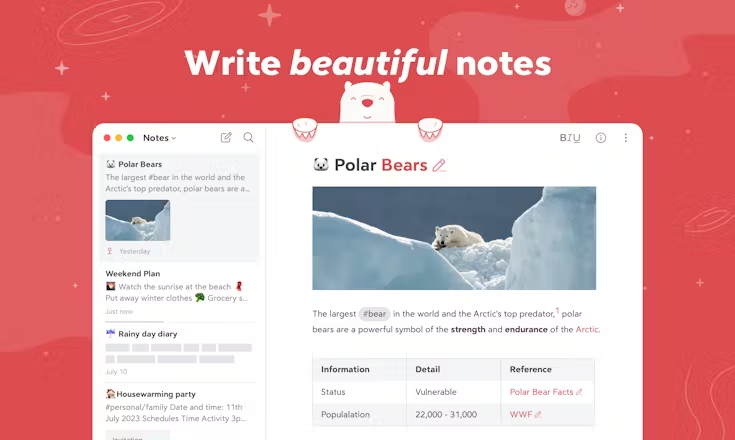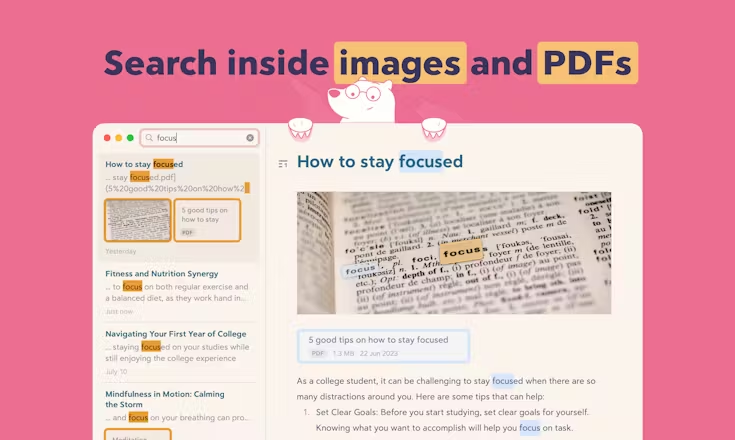Introduction
Bear is a beautifully designed, Markdown-based note-taking and writing app developed for macOS and iOS. It offers a minimalist writing environment that lets you capture anything from quick thoughts to detailed articles, while incorporating powerful organisational features under the hood. Unlike many bloated note apps, Bear emphasises a clean interface where the writing stays front-and-centre, and tools fade into the background.
Writing in Bear uses standard Markdown, meaning your notes remain portable, flexible and future-proof. You can embed images, PDFs, sketches (on iPad with Apple Pencil), code blocks and more—all while navigating through tags and nested tags instead of complex folder hierarchies. The tag-based system is simple: you add hashtags throughout your text to classify your content, then browse via the sidebar.
On the organisational side, Bear supports wiki-style links between notes (via [[Note Name]]), backlinks, tables of contents, full-text search including OCR for images and PDFs, and export options across multiple formats (Markdown, HTML, DOCX, PDF, ePub, JPG) for those who want to share or publish their work. For users who upgrade to the Pro version, there’s iCloud syncing across devices, encryption, custom themes, advanced export features and more.
Bear is a favourite among writers, creatives, students, developers and professionals who prefer a distraction-free, elegant space for their writing—but still want rich structure, portability and power. If you value simplicity interwoven with depth, and you operate in the Apple ecosystem, Bear delivers an experience that’s both polished and purposeful.
🌟 Why You Should Choose
Elegant, distraction-free writing environment – Minimal UI, Markdown focus, and beautiful typography let you simply write, without being burdened by toolbars or complexity.
Flexible organisation via tags and links – Instead of folders, you organise with tags (including nested tags) and wiki-links, making your notes easy to navigate, cross-reference, and grow into a personal knowledge base.
Powerful export and portability – Whether you’re writing blog posts, research papers or simple journal entries, you can export to multiple formats including PDF, DOCX, HTML, ePub, JPG or raw Markdown—keeping your content future-proof.
Full-featured for Apple devices and ecosystem – Native support for iPhone, iPad and Mac, Apple Pencil sketching, Apple Watch widgets, Siri Shortcuts integration and seamless iCloud syncing (with Pro version) make it a strong choice for Apple users.
Advanced features for serious writers – With the Pro upgrade you get iCloud sync, note encryption, OCR search inside attachments, custom themes, multiple app icons, and a professional-level toolset for writing, research or knowledge management.
⚙️ Additional Highlights
Supports Markdown features like headings, code blocks, checkboxes, footnotes, call-outs and tables, enabling rich text beyond basic note-taking.
Built-in search that can look inside images and PDFs (when on Pro) so you can retrieve content even from attachments.
Customisation for appearance: multiple themes and app icons let you craft a writing environment you enjoy.
Exporting via TextBundle format means attachments (images, PDFs) stay with your notes in a portable bundle.
Active development: recent versions support features like math formulas, call-outs in notes, new themes, and a public beta of the web-app companion (though full web/Windows/Android support is still limited).
Strong privacy focus: notes are stored on iCloud (when synced) and are end-to-end private under your Apple account—Bear doesn’t claim access to your content.
Launch Date & Founder Name
First released in 2016.
Developed by a small team under the name Shiny Frog, founded by Danilo Bonardi (CEO) and colleagues.
Pros And Cons
Pros:
- Beautiful, intuitive interface optimized for writing.
- Rich Markdown support with advanced features and export capability.
- Tags and links provide fluid organisational structure without rigid folder systems.
- Excellent performance and native feel on Apple devices.
- Portability of notes via Markdown/TextBundle and custom export formats.
Cons:
- Limited cross-platform support—Windows and Android users must wait for full web or native versions.
- Collaboration and real-time shared editing are not core features—better for personal use than team-driven note sharing.
- Folder-based users may miss the conventional hierarchy view; tag-based system has a learning curve for some.
- Some features locked behind Pro subscription (iCloud sync, advanced export, themes) which may deter budget users.
- For database-style note taking (with relational links and multi-entity structures) tools like Obsidian or Notion may be more suitable.












